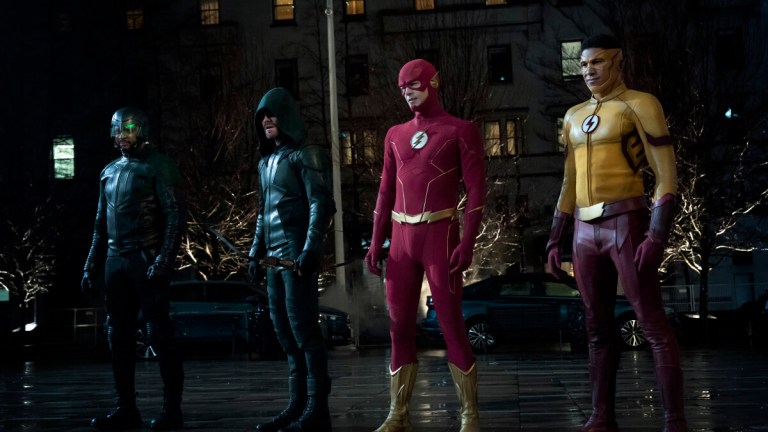The Flash Season 9 Just Completely Changed a Key Part of Crisis on Infinite Earths
The Flash season 9 takes a turn when it's revealed that some of the events of Crisis on Infinite Earths aren't as...permanent as we once thought.

This article contains The Flash spoilers.
The Flash begins its final run of episodes with an hour that will delight longtime Arrowverse fans—and sets up a dramatic new possibility for the series’ endgame. “It’s My Party and I’ll Die If I Want To” may be most memorable for the fact that it brings back former Arrow stars Stephen Amell and David Ramsey—as well as The Flash favorite Keiynan Lonsdale—but it’s the show’s massive change to the very fabric of the Arrowverse as it has been understood since the events of the 2020 mega-crossover Crisis on Infinite Earths that may be the most impactful.
It’s hard to imagine an episode where Barry Allen’s death (however brief it might be) is only the third most interesting thing that happens during it, but here we are. Not only does Sendhil Ramamurthy’s villainous Bloodwork attempt to turn all of Central City into his own personal army of blood zombies, but he also manages to tempt Wally into helping him by corrupting his idea of what a universe free of pain might look like. But although Wally kills Barry in a Bloodwork-fueled rage, we all know that’s not going to be the end of our hero’s story. And instead of passing on to a much-deserved eternal rest, he wakes up in a forest with none other than Arrow’s Oliver Queen.
Oliver, who in case anyone has forgotten, is also technically dead and now possesses the powers of the godlike being known as the Spectre, seems to pull a dead Barry into a sort of limbo—one that bears a more than passing resemblance to Arrow’s island of Lian Yu. He’s saved Barry in order to fill him in on some crucial information that will almost certainly impact the rest of the series’ final season. Because: The multiverse is in danger. Yes, the multiverse, that thing that wasn’t technically supposed to exist anymore after the events of Crisis on Infinite Earths. Well, it’s back—or perhaps more accurately, it turns out it never really left—and Barry and friends will have to act accordingly in order to save it from Ramsey Russo’s plan to infect every world with his blood plague.
How is this possible, you might wonder? Oliver explains that, although he initially assumed that he was merely creating Earth-Prime when he originally became the Spectre, something much larger was actually at work. He was, in fact, creating a brand new multiverse, one meant to replace the one that had fallen in Crisis on Infinite Earths and which encompasses thousands of new worlds.
On some level, this seems fairly obvious. After all, even though the larger Arrowverse seemed pretty insistent that all their heroes now existed in the same world—The Flash characters regularly reference National City, Gotham, and Coast City, and various CW series have played with the ways that the merging of the Earths have changed or even resurrected various heroes and villains—other corners of the live-action DC universe clearly still exist. Stargirl, for example, was clearly set on a new version of Earth-2, and the second season of Superman and Lois confirmed Tyler Hoechlin’s Superman was the only hero on his planet. (And that’s not even touching however you want to categorize the worlds of shows like Titans and Doom Patrol.) But, for whatever reason, no one on Earth-Prime seemed to realize that until right now.
Instead, shows like The Flash have played around with the idea of characters from “alternate timelines” post-Crisis, though it’s never done the best job explaining what, exactly, that means or how it was necessarily different from the multiversal idea of other Earths. (See also, the Red Death storyline, in which a version of Batwoman‘s Ryan Wilder claimed she escaped from her timeline into Barry and Iris’. It’s much easier to just acknowledge that she was always from Earth-4125, isn’t it?)
What the restoration of the multiverse will mean for The Flash’s endgame is, as yet, still unclear. It certainly opens the door—and provides an easy explanation—for more characters and guest stars to return as the series counts down to its final episodes (and, let’s be honest, the end of the Arrowverse as we know it.) It raises the stakes for The Flash’s final adventure, and promises an epic finish of the sort fans are likely expecting from this elder statesman of the superhero genre. And with just four episodes to go, it certainly feels like anything’s possible.
